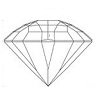16.32: Diaspore
- Page ID
- 4716
\( \newcommand{\vecs}[1]{\overset { \scriptstyle \rightharpoonup} {\mathbf{#1}} } \)
\( \newcommand{\vecd}[1]{\overset{-\!-\!\rightharpoonup}{\vphantom{a}\smash {#1}}} \)
\( \newcommand{\dsum}{\displaystyle\sum\limits} \)
\( \newcommand{\dint}{\displaystyle\int\limits} \)
\( \newcommand{\dlim}{\displaystyle\lim\limits} \)
\( \newcommand{\id}{\mathrm{id}}\) \( \newcommand{\Span}{\mathrm{span}}\)
( \newcommand{\kernel}{\mathrm{null}\,}\) \( \newcommand{\range}{\mathrm{range}\,}\)
\( \newcommand{\RealPart}{\mathrm{Re}}\) \( \newcommand{\ImaginaryPart}{\mathrm{Im}}\)
\( \newcommand{\Argument}{\mathrm{Arg}}\) \( \newcommand{\norm}[1]{\| #1 \|}\)
\( \newcommand{\inner}[2]{\langle #1, #2 \rangle}\)
\( \newcommand{\Span}{\mathrm{span}}\)
\( \newcommand{\id}{\mathrm{id}}\)
\( \newcommand{\Span}{\mathrm{span}}\)
\( \newcommand{\kernel}{\mathrm{null}\,}\)
\( \newcommand{\range}{\mathrm{range}\,}\)
\( \newcommand{\RealPart}{\mathrm{Re}}\)
\( \newcommand{\ImaginaryPart}{\mathrm{Im}}\)
\( \newcommand{\Argument}{\mathrm{Arg}}\)
\( \newcommand{\norm}[1]{\| #1 \|}\)
\( \newcommand{\inner}[2]{\langle #1, #2 \rangle}\)
\( \newcommand{\Span}{\mathrm{span}}\) \( \newcommand{\AA}{\unicode[.8,0]{x212B}}\)
\( \newcommand{\vectorA}[1]{\vec{#1}} % arrow\)
\( \newcommand{\vectorAt}[1]{\vec{\text{#1}}} % arrow\)
\( \newcommand{\vectorB}[1]{\overset { \scriptstyle \rightharpoonup} {\mathbf{#1}} } \)
\( \newcommand{\vectorC}[1]{\textbf{#1}} \)
\( \newcommand{\vectorD}[1]{\overrightarrow{#1}} \)
\( \newcommand{\vectorDt}[1]{\overrightarrow{\text{#1}}} \)
\( \newcommand{\vectE}[1]{\overset{-\!-\!\rightharpoonup}{\vphantom{a}\smash{\mathbf {#1}}}} \)
\( \newcommand{\vecs}[1]{\overset { \scriptstyle \rightharpoonup} {\mathbf{#1}} } \)
\( \newcommand{\vecd}[1]{\overset{-\!-\!\rightharpoonup}{\vphantom{a}\smash {#1}}} \)
\(\newcommand{\avec}{\mathbf a}\) \(\newcommand{\bvec}{\mathbf b}\) \(\newcommand{\cvec}{\mathbf c}\) \(\newcommand{\dvec}{\mathbf d}\) \(\newcommand{\dtil}{\widetilde{\mathbf d}}\) \(\newcommand{\evec}{\mathbf e}\) \(\newcommand{\fvec}{\mathbf f}\) \(\newcommand{\nvec}{\mathbf n}\) \(\newcommand{\pvec}{\mathbf p}\) \(\newcommand{\qvec}{\mathbf q}\) \(\newcommand{\svec}{\mathbf s}\) \(\newcommand{\tvec}{\mathbf t}\) \(\newcommand{\uvec}{\mathbf u}\) \(\newcommand{\vvec}{\mathbf v}\) \(\newcommand{\wvec}{\mathbf w}\) \(\newcommand{\xvec}{\mathbf x}\) \(\newcommand{\yvec}{\mathbf y}\) \(\newcommand{\zvec}{\mathbf z}\) \(\newcommand{\rvec}{\mathbf r}\) \(\newcommand{\mvec}{\mathbf m}\) \(\newcommand{\zerovec}{\mathbf 0}\) \(\newcommand{\onevec}{\mathbf 1}\) \(\newcommand{\real}{\mathbb R}\) \(\newcommand{\twovec}[2]{\left[\begin{array}{r}#1 \\ #2 \end{array}\right]}\) \(\newcommand{\ctwovec}[2]{\left[\begin{array}{c}#1 \\ #2 \end{array}\right]}\) \(\newcommand{\threevec}[3]{\left[\begin{array}{r}#1 \\ #2 \\ #3 \end{array}\right]}\) \(\newcommand{\cthreevec}[3]{\left[\begin{array}{c}#1 \\ #2 \\ #3 \end{array}\right]}\) \(\newcommand{\fourvec}[4]{\left[\begin{array}{r}#1 \\ #2 \\ #3 \\ #4 \end{array}\right]}\) \(\newcommand{\cfourvec}[4]{\left[\begin{array}{c}#1 \\ #2 \\ #3 \\ #4 \end{array}\right]}\) \(\newcommand{\fivevec}[5]{\left[\begin{array}{r}#1 \\ #2 \\ #3 \\ #4 \\ #5 \\ \end{array}\right]}\) \(\newcommand{\cfivevec}[5]{\left[\begin{array}{c}#1 \\ #2 \\ #3 \\ #4 \\ #5 \\ \end{array}\right]}\) \(\newcommand{\mattwo}[4]{\left[\begin{array}{rr}#1 \amp #2 \\ #3 \amp #4 \\ \end{array}\right]}\) \(\newcommand{\laspan}[1]{\text{Span}\{#1\}}\) \(\newcommand{\bcal}{\cal B}\) \(\newcommand{\ccal}{\cal C}\) \(\newcommand{\scal}{\cal S}\) \(\newcommand{\wcal}{\cal W}\) \(\newcommand{\ecal}{\cal E}\) \(\newcommand{\coords}[2]{\left\{#1\right\}_{#2}}\) \(\newcommand{\gray}[1]{\color{gray}{#1}}\) \(\newcommand{\lgray}[1]{\color{lightgray}{#1}}\) \(\newcommand{\rank}{\operatorname{rank}}\) \(\newcommand{\row}{\text{Row}}\) \(\newcommand{\col}{\text{Col}}\) \(\renewcommand{\row}{\text{Row}}\) \(\newcommand{\nul}{\text{Nul}}\) \(\newcommand{\var}{\text{Var}}\) \(\newcommand{\corr}{\text{corr}}\) \(\newcommand{\len}[1]{\left|#1\right|}\) \(\newcommand{\bbar}{\overline{\bvec}}\) \(\newcommand{\bhat}{\widehat{\bvec}}\) \(\newcommand{\bperp}{\bvec^\perp}\) \(\newcommand{\xhat}{\widehat{\xvec}}\) \(\newcommand{\vhat}{\widehat{\vvec}}\) \(\newcommand{\uhat}{\widehat{\uvec}}\) \(\newcommand{\what}{\widehat{\wvec}}\) \(\newcommand{\Sighat}{\widehat{\Sigma}}\) \(\newcommand{\lt}{<}\) \(\newcommand{\gt}{>}\) \(\newcommand{\amp}{&}\) \(\definecolor{fillinmathshade}{gray}{0.9}\)| Diaspore | |
|---|---|
| Chemical composition | AlO(OH) |
| Crystal system | Orthorhombic |
| Habit | Tabular, sometimes fibrous |
| Cleavage | Perfect to imperfect |
| Fracture | Conchoidal |
| Luster | Bright vitreous to pearly (on cleavage surface). |
| Hardness | 6.5 - 7 |
| Optic nature | Biaxial + |
| Refractive index | 1.682 - 1.752 |
| Birefringence | 0.040 - 0.048 |
| Specific gravity | 3.2 - 3.5 |
| Lustre | Vitreous |
| Pleochroism | Moderate |

Figure \(\PageIndex{1}\): Color-changing diaspore from green in daylight to brown in incandescent light - also known as “Zultanite” in the gem market.
Photo courtesy of Chaman Golecha, Gem Testing Laboratory, Jaipur.
Diaspore as a plausible gemstone has been reported first around 1977 when a large enough crystal was examined at the Gem Testing Laboratory in London. This, usually colorless, material showed good color-change from pale bluish-green to pale pinkish-brown. Turkey was the origin of this color-change material. When Zultanite Gems LLC acquired the mining location, this color-change variety of diaspore was marketed under the tradename "zultanite®". At present (2007) sole distribution rights of "zultanite®" are granted to GemsTV.
Chemical composition
AlOOH + Mn (or Fe) as impurity (a dimorph of boehmite).
Mn or Fe may substitute Al in the lattice.
Crystallography
Orthorhombic.
Habit: crystals are elongated plates (tabular); acicular needles also massive; foliated.
Diagnostics
Diaspore may be confused with peridot due to the strong doubling of back facets, but diaspore is usually much paler in color. Iron-rich green sapphire has an absorption spectrum close to diaspore.
Color
Colorless, pale bluish-green to pale green, pale pinkish-brown to pale brown.
Diaphaneity
Transparent to opaque.
Specific Gravity
S.G.:3.2 - 3.5 (mean = 3.4)
Cleavage
Perfect in one direction {010} and imperfect on {110} and {210}.
Refractometer
Optic nature: Biaxial positive.
Refractive index range: nα = 1.682 - 1.702, nΒ = 1.705 - 1.725 and nγ = 1.730 - 1.752. Mean = 1.702 - 1.750.
Maximum birefringence: 0.040 - 0.048.
Spectrum
Not diagnostic but Turkish stones 471, 463, 454 (much similar to iron-rich sapphire).
Luminescence
UV fluorescence: May show dull pale yellow (LW) and green (SW)
Pleochroism
Strong depending on body color and source. Blue / Pale green and rose to dark red.
Magnification
Diaspore is a type II stone on the GIA clarity scale, hence small inclusions are usually found.
Phenomena
- Color-change
- Cat's-eyes
Simulants
| Sapphire | No strong doubling of facets; higher heft; higher R.I., unixial figure. |
| Sillimanite | Lower S.G., lower RI and lower birefringence. |
| Peridot | Lower RI and slightly lower birefringence. |
Occurrence
Geological occurrence:
In metamorphosed limestones, chloritic schists and altered igneous rocks. Also in bauxite deposits.
Geographical locations:
Memaris, Turkey (gemmy pale brown); Chester, Massachusetts (with corundum); Pennysylvania (fine transparent colourless to brown); Hungary; South Africa in Postmasburg district - Manganiferous variety; Cornwall, England; Greenland; Norway; Sweden; France; Switzerland; Germany; Greece; USSR; Japan; China; Turkey.
References
- Gems Their Sources, Descriptions and Identification 4th Edition (1990) - Robert Webster (6th ed.)
- Colour Encyclopedia - J.E. Arem ISBN 0412989115
- Textbook of mineralogy - E.S. Dana
- Introduction to Optical Mineralogy 3rd edition (2003), Prof. W.D. Nesse


